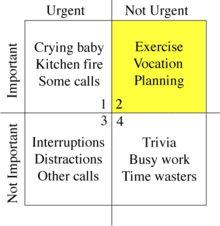“The urgent problems are seldom the important ones.”
– Former President Dwight D. Eisenhower
 Has this ever happened to you? At the end of a hectic day, you sit down and find yourself thinking of all the things that you tackled. You realize that you kept yourself extremely busy, but for some reason you don’t feel like you truly accomplished anything. You still have a long list of important to-dos… good intentions that have been on that darn list for weeks, even months. You ask yourself, “If I’m doing so much, why do I feel like I’m going nowhere?”
Has this ever happened to you? At the end of a hectic day, you sit down and find yourself thinking of all the things that you tackled. You realize that you kept yourself extremely busy, but for some reason you don’t feel like you truly accomplished anything. You still have a long list of important to-dos… good intentions that have been on that darn list for weeks, even months. You ask yourself, “If I’m doing so much, why do I feel like I’m going nowhere?”
The fact is, staying busy is not the same as staying on top of things. You see, good time management means being effective as well as efficient. Managing time effectively, and achieving the things that you want to achieve, requires spending the majority of your time on things that are important and not just urgent.
Let’s look at the difference between the two:
- Important activities have an outcome that leads to the achievement of your goals, whether these are professional or personal.
- Urgent activities demand immediate attention, and are often associated with the achievement of someone else’s goals.
Urgent activities are often the ones we concentrate on; they demand attention because the consequences of not dealing with them are immediate.
 In First Things First, Stephen Covey describes a framework for prioritizing to-dos that is essentially aimed at long-term goals, at the expense of tasks that appear to be urgent, but are in fact less important.
In First Things First, Stephen Covey describes a framework for prioritizing to-dos that is essentially aimed at long-term goals, at the expense of tasks that appear to be urgent, but are in fact less important.
Here’s how it works… this 2×2 matrix classifies tasks as urgent and non-urgent on one axis, and important or non-important on the other axis (see diagram).
Unfortunately, we tend to spend most of our time in quadrant 1 putting out fires, and quadrant 3 wasting time on distractions. His quadrant 2 has the items that are non-urgent but important. These are the ones he believes we are likely to neglect; but, should focus on to achieve effectiveness. The problem is, when you ignore these important but non-urgent tasks in quadrant 2, they soon become urgent. You then find yourself running around like a chicken with your head cut off!
It really comes down to finding balance. Try spending most of your day doing important tasks in quadrant 2. Keep in mind that it’s inevitable that you will have to spend some time on urgent quadrant 1 tasks. When an urgent to-do pops up, remember to ask yourself…
“I know this is urgent, but is it really important?”
If the task really falls into quadrant 3, resist the temptation to do it! Don’t waste your time on unimportant things. It really won’t hurt to let it fall through the cracks… or better yet, delegate it to someone else to do.
As for quadrant 4, be honest with yourself: what activities do you find yourself doing that are neither important or urgent? And how many of these activities prevent you from focusing on the important ones in quadrant 2? A lot of these time suckers may seem relaxing, easy to do, and even fun, but they will never help you achieve what you really want in life.
